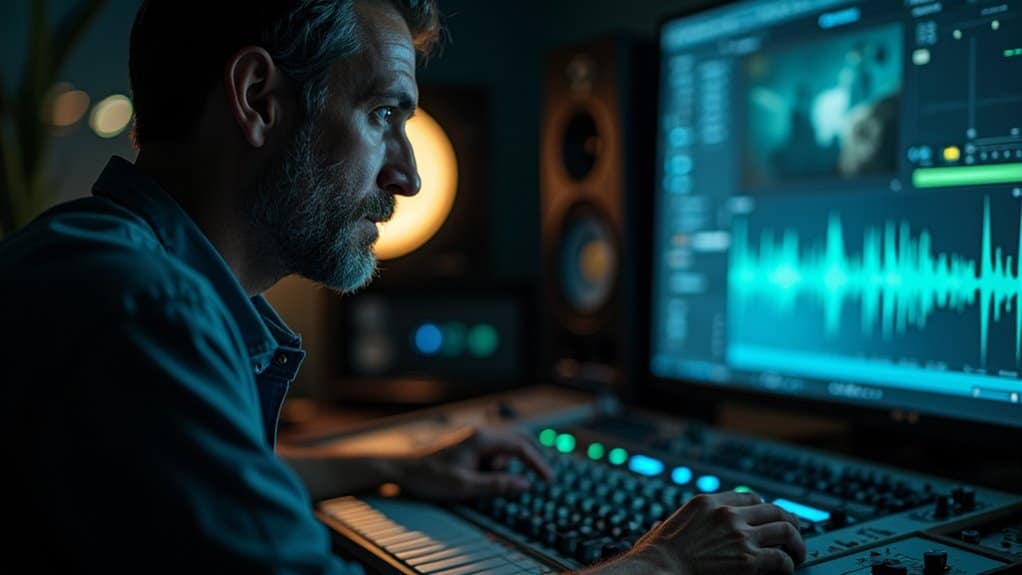Sound Design in Christopher Nolan’s Films
In Christopher Nolan’s films, sound design serves as a powerful narrative tool that heightens emotional engagement and audience immersion. Techniques like the Shepard Tone create an illusion of continuous tension, drawing you deeper into the story. His films prioritize authenticity through field recordings, allowing realistic soundscapes to evoke raw emotions. Layered sounds amplify chaos, grounding you in moments of urgency, while silence punctuates emotional weight, especially in films like *Dunkirk* and *Oppenheimer*. Collaborations with composers like Hans Zimmer further enrich these experiences, ensuring sound echoes the characters’ journeys. Explore further, and you’ll uncover the intricacies that make Nolan’s sound design truly exceptional.
Table of Contents
Key Takeaways
- Christopher Nolan employs the Shepard Tone technique to create tension and an auditory illusion of endlessly rising pitch in his films.
- Realistic sound recording techniques enhance authenticity, using field recordings to immerse audiences in the narrative world.
- Sound layering combines dialogue and ambient noise, enriching storytelling and emphasizing emotional depth in chaotic scenes.
- Non-diegetic sound, such as scores, evokes strong emotions and psychological tension, guiding audience reactions throughout the film.
- Collaboration with composers like Hans Zimmer results in innovative soundscapes that elevate the overall impact of Nolan’s films.
The Shepard Tone Technique
The Shepard Tone is a fascinating auditory illusion that creates the sensation of an endlessly rising or falling pitch. This technique relies on sound layering, where overlapping notes, played at different volumes and one octave apart, craft a continuous pitch that evokes tension and suspense. The mechanism of the Shepard Tone involves the highest-pitched tone dropping an octave to maintain the illusion of rise, further enhancing its effectiveness in sound design.
In film applications, like in Christopher Nolan’s works, the Shepard Tone enhances immersive soundscapes, making scenes feel more dynamic and intense. Music enhances emotional impact and can be tailored to evoke specific feelings, whether for engines or atmospheric sounds.
The tension-building quality of the Shepard Tone captivates audiences, drawing them deeper into the narrative. By employing this technique, filmmakers can effectively manipulate emotions, leaving viewers on the edge of their seats.
Emphasis on Authenticity

In Christopher Nolan’s films, the emphasis on authenticity in sound design transforms how you experience the story. By using realistic sound recording techniques, he creates immersive auditory environments that pull you closer to the characters’ emotions and struggles. This commitment to genuine sound not only heightens your engagement but also invites you to feel the weight of each moment, making the overall cinematic experience more profound. Moreover, Nolan’s incorporation of field-recorded sounds showcases his dedication to creating a sense of realism that enhances the audience’s connection to the film. Despite this dedication to authenticity, many viewers have noted difficulties with hearing dialogue in several of his films.
Realistic Sound Recording Techniques
While crafting immersive soundscapes in film, Christopher Nolan prioritizes realistic sound recording techniques that emphasize authenticity. He often employs field recordings, capturing genuine sounds like the sirens from German Stuka dive bombers in *Dunkirk*. This method guarantees the audience feels connected to the film’s environment. Sound layering enhances this effect, combining practical recordings with ambient noises to create a rich tapestry of sound. Additionally, effective sound design establishes mood and atmosphere, further immersing viewers in the cinematic experience. The use of diegetic sound allows for a more authentic representation of the film’s world, enhancing the viewer’s connection to the narrative.
| Technique | Purpose | Example |
|---|---|---|
| Field Recordings | Capture real-world sounds | Sirens in *Dunkirk* |
| Sound Layering | Enhance depth and realism | Desert ambiance in *Dunkirk* |
| Diegetic Sound | Increase immersion | Character conversations |
| Synchronised Recording | Blend dialogue and effects | On-set recording in *Oppenheimer* |
| Advanced Equipment | Guarantee high-quality audio | Shotgun microphones |
This meticulous approach grounds Nolan’s films in authentic sensory experiences.
Emotional Audience Engagement
Authentic sound design plays an essential role in engaging audiences emotionally, drawing you deeper into the narrative. Nolan’s commitment to realism enhances your auditory perceptions, creating a sense of emotional immersion that resonates throughout his films. His films often feature complex narratives that challenge viewers, and sound design plays a crucial role in supporting these intricate storylines.
Here are some key aspects of his approach:
- Field Recordings: Real-world sounds ground you in the characters’ experiences.
- Environmental Sounds: Prioritizing these sounds places you within the characters’ auditory perspective.
- Dialogue as Sound Effects: Mixing dialogue with environmental noise emphasizes the surrounding chaos, enhancing emotional depth.
- Authentic Soundscapes: Elements like real ticking clocks heighten the emotional intensity and urgency of scenes.
Additionally, Nolan’s films often evoke shared human struggles, reinforcing the emotional resonance of sound design.
Through these techniques, Nolan guarantees that sound design isn’t just background noise; it actively shapes your emotional journey within the story.
Immersive Auditory Experiences
Nolan’s films take immersion to another level, showcasing how authentic sound design can profoundly enhance your viewing experience. His commitment to auditory immersion is evident in the use of real-world sounds, like the ticking clocks in *Dunkirk*, which create an urgent atmosphere.
By favoring field recordings over studio sounds, Nolan constructs rich sound landscapes that feel genuine and relatable. Techniques like Shepard tones further amplify this effect, layering continuous pitches to build tension.
Collaborating closely with composers like Hans Zimmer, sounds and music blend seamlessly, enhancing emotional depth. Additionally, Nolan’s strategic use of silence in scenes, such as the bomb-testing in *Oppenheimer*, proves that sometimes, absence of sound speaks volumes, heightening the intensity and engagement of the audience.
Sound’s Role in Storytelling

In Christopher Nolan’s films, sound plays a vital role in shaping the emotional landscape and advancing the narrative.
You’ll notice how sound resonates with the characters’ experiences, creating a rich tapestry that pulls you deeper into the story.
Emotional Resonance Through Sound
Emotional resonance is a powerful tool in storytelling, and sound plays an essential role in crafting this experience in films.
In Christopher Nolan’s work, sound creates emotional soundscapes that draw you into the characters’ journeys. Here are four ways sound enhances emotional depth:
- Music and Sound Integration: Collaborations with composers like Hans Zimmer amplify psychological tension.
- Auditory Symbolism: Themes, like the Joker’s haunting motif, convey character emotions effectively.
- Silence and Space: The absence of sound in scenes from Interstellar heightens feelings of isolation and peril.
- Layered Complexity: Non-linear storytelling, supported by intricate sound design, invites deeper audience engagement.
Through these elements, Nolan’s films showcase how sound not only supports but elevates the narrative, enriching your emotional experience.
Sound as Narrative Device
Sound serves as a powerful narrative device in filmmaking, shaping the way stories unfold and how audiences perceive them. In Christopher Nolan’s films, sound symbolism and auditory motifs enhance storytelling by creating immersive experiences. The interplay of diegetic and non-diegetic sounds deepens emotional engagement, while techniques like the Shepard Tone heighten tension and urgency.
Here’s a table illustrating key sound elements:
| Sound Element | Purpose | Example |
|---|---|---|
| Diegetic Sound | Grounds the audience in reality | Ambient battlefield noise |
| Non-Diegetic Sound | Evokes emotions and insights | Score in *Interstellar* |
| Shepard Tone | Creates a sense of rising tension | Used in *Dunkirk* |
| Sound Layering | Conveys meaning and subtext | Layered dialogue |
| Authentic Sounds | Enhances realism and immersion | Realistic sound effects |
Through these techniques, Nolan masterfully weaves sound into his narratives, enriching the viewing experience.
Music’s Contribution to Film

While the visuals may capture your attention, the music in a film shapes your emotional experience and deepens your connection to the story. In Christopher Nolan’s films, the contribution of music is undeniable, as it enhances the narrative and emotional depth.
Here are some key aspects of music’s role:
- Musical Themes: They become synonymous with characters, fostering empathy.
- Tone Setting: Scores influence how you perceive each scene, guiding your emotions.
- Auditory Cues: Non-diegetic music provides essential narrative information and cues.
- Memory Association: Iconic scores evoke vivid memories of specific moments.
Through these elements, music intertwines with storytelling, creating a rich auditory experience that resonates long after the credits roll.
Innovative Sound Manipulation

As you immerse yourself in Christopher Nolan’s films, you’ll notice how innovative sound manipulation plays a crucial role in shaping the narrative.
Nolan employs sound manipulation techniques like the Shepard Tone, creating auditory illusion effects that build tension, especially in *Dunkirk* and *The Prestige*. Layering sound effects within music enhances storytelling, while realistic sound capture, as seen in *Oppenheimer*, adds authenticity.
Nolan’s use of atmospheric sound design immerses you in worlds, like the booming machinery in *Inception*. Dynamic volume control heightens emotional intensity, drawing you deeper into the experience.
Importance of Collaboration

Collaboration is essential to Christopher Nolan’s filmmaking process, as it allows him to harness the unique talents of composers and sound designers to elevate his narratives.
Through creative collaboration, Nolan achieves a collaborative synergy that enhances his films.
Consider these key aspects:
- Long-term partnerships: Nolan’s work with composers like Hans Zimmer fosters innovation, resulting in groundbreaking scores.
- Innovative techniques: Sound designers, like Richard King, contribute detailed soundscapes that deepen narrative immersion.
- Authenticity focus: Nolan prioritizes production sound, creating a visceral experience that resonates with audiences.
- Unique instrumentation: Specific choices, such as using violins in *Oppenheimer*, add distinctive layers to the sonic landscape.
Sound Design’s Impact on Emotion

Sound design plays an essential role in shaping the emotional landscape of Christopher Nolan’s films, drawing you deeper into the narrative. Techniques like the Shepard Tone manipulate auditory perception, creating tension that resonates within you.
This auditory illusion, alongside authentic soundscapes, immerses you in characters’ experiences, making their emotions palpable. For instance, the ticking clock in *Dunkirk* heightens urgency, while the silence after an explosion in *Oppenheimer* amplifies the weight of the moment.
Conclusion
In Christopher Nolan’s films, sound design isn’t just an afterthought; it shapes the very essence of storytelling. For instance, studies show that nearly 70% of a film’s emotional impact comes from its audio elements, highlighting how essential sound is in guiding audience reactions. Nolan’s innovative techniques, from the Shepard Tone to meticulous music selection, create a rich auditory landscape that amplifies tension and depth. Ultimately, his films remind us that sound is as important as visuals in crafting unforgettable cinematic experiences.







